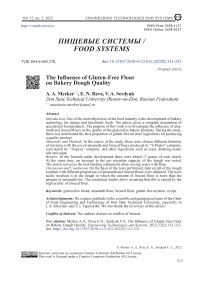The influence of gluten-free flour on bakery dough quality
Автор: Merker Anastasia A., Reva Ekaterina N., Serdyuk Valentina A.
Журнал: Инженерные технологии и системы @vestnik-mrsu
Рубрика: Пищевые системы
Статья в выпуске: 2, 2022 года.
Бесплатный доступ
Introduction. One of the main objectives of the food industry is the development of bakery technology for dietary and functional foods. The article gives a complete description of specialized food products. The purpose of this work is to investigate the influence of amaranth and linseed flours on the quality of the gluten-free bakery products. During the study, there was determined the best proportion of gluten-free mixture ingredients for producing a quality product. Materials and Methods. In the course of the study, there were chosen different formulas of mixtures with the use of amaranth and linseed flours produced by “S.Pudov” company, corn starch by “Trapeza” company, and other ingredients such as yeast, drinking-water, salt and sugar. Results. To the formula under development there were added 17 grams of corn starch. At the same time, an increase in the gas retention capacity of the dough was noted. The starch served as the best binding component when mixing water with flour. Discussion and Conclusion. On the basis of the tests performed, data on pH of the dough medium with different proportions of amaranth and linseed flours were obtained. The most acidic medium is in the dough in which the amount of linseed flour is more than the amount of amaranth one. The conducted studies allow assuming that this is caused by the high acidity of linseed flour.
Gluten-free bread, amaranth flour, linseed flour, gluten-free mixture, recipe
Короткий адрес: https://sciup.org/147237989
IDR: 147237989 | УДК: 664.6:664.230 | DOI: 10.15507/2658-4123.032.202202.313-323
Текст научной статьи The influence of gluten-free flour on bakery dough quality
Gluten type of vegetable protein found in wheat, barley, rye. Gluten plays an important role in the formation of important elastic bonding when mixing dough. In the absence of gluten in flour products there are such problems as lack of 314
swelling (gas retention capacity), elasticity, openness, etc. [1‒4]. But gluten-free bakery products are gaining popularity. This increase in the popularity of gluten-free products is caused by an increase in the number of people suffering from gluten intolerance. The only treatment for this disease is a strict gluten-free diet. In addition, the problem of healthy eating today is relevant in view of the increase in allergic and genetic diseases, as well as of the serious environmental situation in the world.
One of the main goals of the food industry is the development of specialized bakery products for dietary and functional nutrition. The main types of flour used for the production of such bakery products are following types of flour: buckwheat, amaranth, rice, linen, maize, hemp, etc [5–7].
Today, the Russian market of gluten-free products is represented by a rather small assortment, because most production depends directly on imports. Despite the fact that according to various data, 0.5–1.0% of the population in the Russian Federation has gluten intolerance, the question of increasing the baking production is very important. In order to solve this problem, it is necessary to increase the production of “useful” products and improve their quality through using new, improved approaches and production technologies [8].
For developing new technologies and formulas of gluten-free bakery products, Russia has been gained considerable experience. Every year, more and more nutritionists choose to research raw materials for specialized foods. The purpose of this work is to investigate the impact of amaranth and linseed flour on the quality of the gluten-free bakery products.
The research objectives of this paper are as follows:
-
– to conduct physic-chemical analysis of amaranth and linseed flour;
-
– to develop the optimal formulas for the addition of amaranth and linseed flour;
-
– to develop a pilot plan and methodology of the experiment;
-
– to analyze the formulas received;
– to development the optimum formula for producing gluten-free bread using amaranth and linseed flour, and study the rheological characteristics of the dough depending on the quantitative content.
Literature review
The scientists have made an indispensable contribution to the development of gluten-free bakery products are L. N. Kazanskaya, N. D. Sinyavskaya, V. N. Krasilnikov, N. V. Barsukova, N. A. Leontieva, T. B. Tsyganova, T. I. Schneider, D. V. Schneider, V. S. Mehtiyev etc.
But the question of enriching gluten-free bakery products through using non-conven-tional raw materials needs further study.
In the article by T. V. Orlova and P. I. Kudinov, there are presented developed formulas and technologies of producing gluten-free bakery products with the use of gluten-free flour mixtures. The formulas of these flour mixtures include rice, quinoa and buckwheat flours. The article also analysed production regimes and bakery product formulas [1; 9].
In the work by E. V. Nelubina and E. N. Urbancik there are considered technologies of making bread based on gluten-free pea raw materials. The research has resulted in producing a new product of high energy and biological value [2; 10]. P. Zh. Anashkina, E. V. Moskvicheva etc. in their scientific paper investigated gluten-free flour types for making bakery products. The work evaluated the organoleptic, physico-chemical and functional-technological properties of the flours under studying to determine the proportion of the flour mixture for producing a quality bakery product [3; 11].
L. V. Zaitseva and T. A. Yudina in their scientific paper studied modern approaches to the formulas of gluten-free products and developed the formulas for making gluten-free bakery products enriched with proteins and food fibers. For this purpose, unconventional flour such as chia seed flour and lupine flour were used. Thus, the resulting product expanded the assortment of gluten-free products with an increase in their non-dietic and dietary orientation, due to the high fiber content dietary fibers [4; 12].
In their article, S. Dracula, D. Novotni described a study aimed at determining the influence of partial substitution of flour coarse grinding with yellow pea flour on phenols and the antioxidant capacity of gluten-free sour and bread. The research has shown the value of using fermentation in a carefully proportioned sour when adding pea flour to gluten-free bread, which allows for a high antioxidant potential [13].
S. A. Urubkov and S. S. Khovanskaya in their article considered a limited range of functional products for children with limited nutrition. It was concluded that it is necessary to expand the production of specialized gluten-free products. The authors also considered the possibility of using dry gluten-free mixtures for children, where the main component is rice and amaranth flour with the addition of fruit, vegetable and berry raw materials [8; 14].
All of these sources reveal most of the problems associated with producing foods for particular nutritional uses.
Materials and Methods
In the course of the study, there were chosen different formulas of mixtures with the use of amaranth and linseed flours produced by “S.Pudov” company, corn starch by “Trapeza” company, and other ingredients such as yeast, drinkingwater, salt and sugar1 [15; 16].
Bread formula is presented in table 1.
T a b l e 1
Gluten-free bread formula per 100 g
|
Name of ingredient |
Model no. 1 |
Model no. 2 |
Model no. 3 |
|
Amaranth flour, g |
60.0 |
50.0 |
40.0 |
|
Linseed flour, g |
40.0 |
50.0 |
60.0 |
|
Starch, g |
17.0 |
17.0 |
17.0 |
|
Yeast, g |
1.5 |
1.5 |
1.5 |
|
Salt, g |
0.2 |
0.2 |
0.2 |
|
Sugar, g |
0.5 |
0.5 |
0.5 |
|
Water, ml |
150.0 |
137.0 |
110.0 |
The formulas differed in the quantity of several flour types and the amount of water consumed, while other ingredients remained in the same proportion [17–21]. Based on the formula developed, three dough samples were mixed with a bread maker as shown in Figure 1.
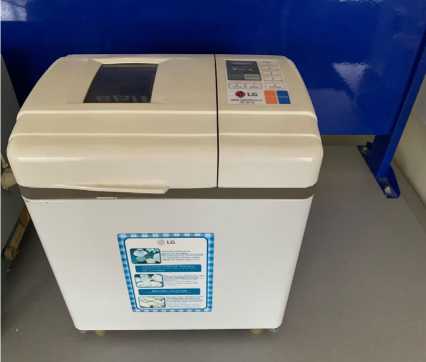
F i g. 1. Bread maker
The ready dough was tested for a number of important indicators such as: the dough acidity, pH, the value of the critical shear stress and the organoleptic estimation [4; 20–22]. All researches were carried out in the laboratory of Biochemical and Spectral Analysis of Food Products of the Chair of Food Engineering and Technology of Don State Technical University.
Determination of the dough acidity
During the dough maturation, a number of organic acids are accumulated in it: lactic, acetic, propionic and others. All they have a characteristic odor affecting the taste and smell of the bakery products. The flour acidity has a significant influence on the quality of the finished bakery products. The level of acidity of flour depends on the variety and duration of storage [23–26]. High flour acidity results in high initial dough acidity and rapid acid accumulation during fermentation. The acidity level was determined according to GOST 5670-962. Preparation of the mixture: batch of test sample 5 g was dissolved in 50 ml of distilled water; 3 drops of phenolphthalein were added to the beaten-up flour and water, and was titrated with 0.1h NaOH until a light pink color was formed that did not disappear within 30 seconds. Figure 2 shows the coloring of the mixture.
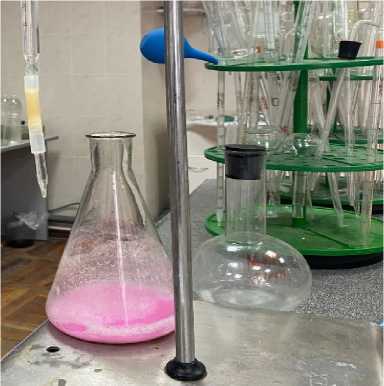
F i g. 2. Titration of the mixture
Acidity is one of the most important indicators not only of readiness but also of quality, since the composition and quantity of acids have a particular influence on the most important processes in mixing the bread dough, and in consequence, influence the organoleptic characteristics of the finished product [27–30].
Determination of pH
Determination of pH is performed with a pH-meter “Expert pH”, the device is shown in Figure 3, intended to measure pH activity and the mass concentration of OH and H ions in the test samples.
Measurement error is 0.001. Sample preparation: 5 g of sample was put in a measuring bulb and dissolved in 20 ml of distilled water, and then pH was measured with a measuring transducer.
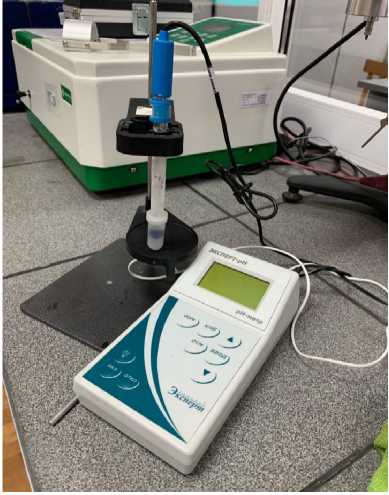
F i g. 3. PH-meter “Expert pH”
A large quantity of compounds or elements in flour helps to maintain a suitable acid-alkali balance for a particular type of flour. It allows controlling and fermentation processes [31–34].
Determination of the critical shear stress
Critical shear stress means the force necessary to deform a product. The consistency of the dough is determined with a device called a conical plastometer [35–38]. The method of determination is shown in Figure 4.
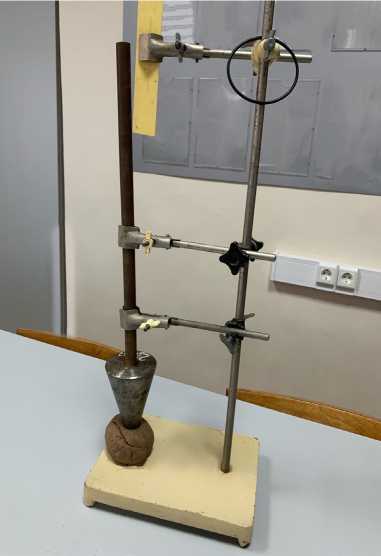
F i g. 4. Unit for determination the shear stress
The test mass is placed on the surface of the unit, the top of the cone comes into contact with the mass surface. The depth of the cone immersion is determined with a ruler [39–41]. The depth of immersion of the material is fixed in the results of the measurements, and then the critical shear stress is determined according to formula:
7 0 = K a X P- , h max
Pr – cone load; Ka – cone constant, depending on the angle at the vertex ( K = 2); h m 2 ax – immersion value in an investigated material.
Results
In the development of the recipe, cornstarch was added as it increases the test’s gas retention capacity, as well as removing moisture and is a binding component when water and flour are combined. The results of the shear stress determination are presented in Table 2.
T a b l e 2
Research results
|
Parameter |
Shear stress |
pH |
|
Model no. 1 |
1.00 |
5.00 |
|
Model no. 2 |
1.00 |
5.00 |
|
Model no. 3 |
1.00 |
5.00 |
Based on the results obtained, we can assume that as the quantity of linseed flour increases, the value of shear stress increases. This suggests that the high content of linseed flour worsens the rheological properties of the dough, such as elasticity.
One of the most important indicators of the quality of finished products is acidity. It is a measure of total acidity as a proxy; titled acidity is the sum of free protons and non-dissociated acids in solution. Quantitative indicators of acidity are presented in Figure 5.
Bakery products with a high content of linseed flour are more acidic and of a lower specific volume. It was noted that the acidity of sample 3 is higher than that of the rest of the samples, which is related to the fact that linseed flour has a high content of organic acids: acetic, apple and lemon.
The main difference between pH and titrated acidity is that pH measures the concentration of free protons in a solution, while titrated acidity measures the sum of free protons and non-dissociated acids in a solution [42–44]. The research results are presented in Table 2
The results of the studies show that in sample 1 with a high content of amaranth flour, the pH is less acidic than in sample 3 with a predominantly linseed flour.
Discussion and Conclusion
When comparing the two types of flour, amaranth and linseed, it turns out that the sample with linseed flour has a fairly high content of protein and food fibers, while amaranth flour is high carbohydrate and has a low content of proteins and fats.
Пищевые системы
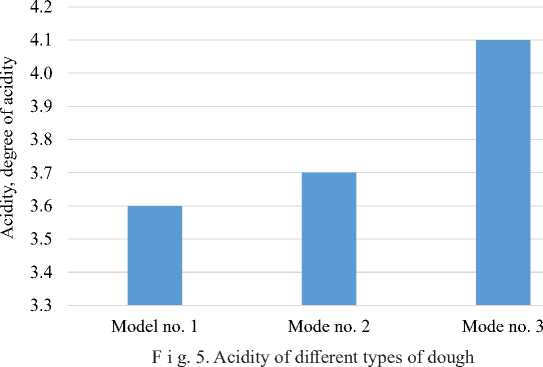
In the course of the research, optimal formulas of mixtures with the use of amaranth and linseed flours were selected. As a result of the research, the dependence of the quantitative water content on the flour was revealed. In sample no. 3, where the content of amaranth and linseed flours was 40 and 60 g, respectively, the total amount of water used for dough kneading was 1.5 times more than for sample no. 1, where the content of amaranth and linseed flours was 60 and 40 g, respectively. The sample with high amaranth flour content (sample 1) required the most water to kneading the dough of homogeneous consistency. It can be concluded that amaranth flour has a high water-absorption capacity.
With regard to rheological properties, there is a correlation: the depth of immersion is decreasing with increasing the shear stress value. Acidity has a great influence on the quality of finished bakery products. The experience shows that bread with a high content of linseed flour has an acidity index of 4.1, indicating that this type of dough has acid medium. Bakery products with increased acidity are more acidic at the end of the baking process.
On the basis of the tests carried out, there were obtained the data on pH of dough with different proportions of amaranth and linseed flours. The most acidic type of dough is one, in which the amount of linseed flour is more than of amaranth flour. Based on these studies, it can be assumed that this is caused by high acidity of linseed flour.
Thus, the research showed that the optimal content of amaranth and linseed flour when kneading dough is 40 and 60% respectively. The high nutritional value of linseed flour and the high content of fiber, which improves digestion, leads to faster saturation and releasing of toxins, while substances contained in amaranth flour are enzymes, which normalize the acidity of the gastric juice and enhance secretory function of the stomach and intestines, provide a good end product with high biological value and significant nutrient content.
Food systems 319
Submitted 02.02.2022; approved after reviewing 20.03.2022; accepted for publication 10.04.2022
Список литературы The influence of gluten-free flour on bakery dough quality
- Orlova T.V., Kudinov P.I. [Development of the Recipe and Production Technology for Bread on the Basis of Gluten-Free Flour Mixtures]. Polzunovskiy vestnik. 2020;(2):50-57. Available at: https://ojs. altstu.ru/index.php/PolzVest/issue/view/7/7 (accessed 20.01.2022). (In Russ.)
- Nialiubina A.V., Ourbantchik A.M., Kaminskaya V.S., et al. Elaboration of Bread-Baking Technology Based on Gluten-Free Fermented Pea Product. Food Industry. 2019;(4):71-72. (In Russ., abstract in Eng.) doi: https://doi.org/10.24411/0235-2486-2019-10035
- Anashkina P.Zh., Moskvicheva E.V., Timoshenkova I.A., Moskvichev A.S. A Study of Gluten Free Flour Types for the Production of Bakery Products. International Research Journal. 2021;(1):98-104. (In Russ., abstract in Eng.) doi: https://doi.org/10.23670/IRJ.2021.103.1.014
- Zaytseva L.V., Yudina T.A., Ruban N.V., et al. Modern Approaches to the Development of Gluten-Free Bakery Formulations. Problems of Nutrition. 2020;89(1):77-85. (In Russ., abstract in Eng.) doi: https://doi.org/10.24411/0042-8833-2020-10009
- Zharkova I.M., Samokhvalov A.A., Gustinovich V.G., et al. Review of Bakery Products for Gluten Free and Herodietetic Nutrition. Proceedings of the Voronezh State University of Engineering Technologies. 2019;81(1):213-217. (In Russ., abstract in Eng.) doi: https://doi.org/10.20914/2310-1202-2019-1-213-217
- Popov VG., Hajrullina N.G., Sadykova H.N. Trends in the Use of Gluten-Free Flours in the Production of Functional Products. Proceedings of the Voronezh State University of Engineering Technologies. 2021;83(1):121-128. (In Russ., abstract in Eng.) doi: https://doi.org/10.20914/2310-1202-2021-1-121-128
- Anashkina P.Zh., Moskvicheva E.V., Timoshenkova I.A. Using Non-Traditional Types of Vegetable Raw Materials in Bakery Products. International Research Journal. 2020;(8):105-110. (In Russ., abstract in Eng.) doi: https://doi.org/10.23670/IRJ.2020.98.8.015
- Urubkov S., Khovanskaya S., Smirnov S. Prospects for Using Amaranth and Native Buckwheat in Dry Gluten-Free Mixes for Children with Gluten Intolerance. Food Processing: Techniques and Technology. 2020;50(2):232-241. (In Russ., abstract in Eng.) doi: https://doi.org/10.21603/2074-9414-2020-2-232-241
- Shchekoldina T.V. [Mixing Technology of Gluten-Free Flour Mixtures Based on Quinoa]. Pol-zunovskiy vestnik. 2019;(3):19-24. Available at: https://elibrary.ru/item.asp?id=41292254& (accessed 20.01.2022). (In Russ.)
- Rutskaya V.I. Experience of Use of Lupin and Products of Its Processing in Food Industry (Review). Legumes and Groat Crops. 2021;(1):83-89. (In Russ., abstract in Eng.) doi: https://doi. org/10.24412/2309-348X-2021-1-83-89
- Feofilaktova O.V., Ponomarev A.S. Technological Property Research of the Alternative Flour Types while Food Producing in Catering in Catering. Food Industry. 2019;4(2):28-34. (In Russ., abstract in Eng.) doi: https://doi.org/10.29141/2500-1922-2019-4-2-4
- Khodyreva Z.R., Schetinin M.P., Musina O.N., et al. Development of a Daily Diet for Children with Celiac Disease in Municipal Pre-School Educational Institutions. Problems of Nutrition. 2021;90(2):110-116. (In Russ., abstract in Eng.) doi: https://doi.org/10.33029/0042-8833-2021-90-2-110-116
- Drakula S., Novotni D., Mustac N.C., et al. Alteration of Phenolics and Antioxidant Capacity of Gluten-Free Bread by Yellow Pea Flour Addition and Sourdough Fermentation. Food Bioscience. 2021;44. doi: https://doi.org/10.1016/j.fbio.2021.101424
- Urubkov S.A., Khovanskaya S.S., Pyrieva E.A., et al. Gluten-Free Dry Mixtures with Rice and Amaranth for Children over Three Years Old with Gluten Intolerance. Food Industry. 2020;5(1):23-31. (In Russ., abstract in Eng.) doi: https://doi.org/10.29141/2500-1922-2020-5-1-3
- Ushakova J.V., Paskova E.M., Rysmukhambetova G.E., Kulevatova T.B. Influence of the Composition of Composite Mixtures with a Reduced Gluten Content on the Rheological Properties of the Dough Based on Their Basis. New Technologies. 2020;(4):74-83. (In Russ., abstract in Eng.) doi: https://doi. org/10.47370/2072-0920-2020-15-4-74-83
- Moskvicheva E.V., Safonova E.E., Timoshenkova I.A. Use of Flour from Seeds of Holy Thistle in the Manufacture of Gluten-Free Products. International Research Journal. 2017;(8)46-50. (In Russ., abstract in Eng.) doi: https://doi.org/10.23670/IRJ.2017.62.062
- Tiunov V.M., Chugunova O.V., Zavorokhina N.V. Feasibility of the Recipe Composition and Technological Features of Dry Mixtures Production for Gluten-Free Flour Culinary Products. Bulletin of South Ural State University, Series "Food and Biotechnology". 2018;6(1):23-31. (In Russ., abstract in Eng.) doi: https://doi.org/10.14529/food180103
- Bavykina I.A., Zvyagin A.A., Miroshnichenko L.A., et al. Efficient Products from Amaranth in a Gluten-Free Nutrition of Children with Gluten Intolerance. Problems of Nutrition. 2017;86(2):91-99. Available at: https://elibrary.ru/item.asp?id=28990194 (accessed 20.01.2022). (In Russ., abstract in Eng.)
- Kuznetsova L.I., Savkina O.A., Parakhina O.I., Lokachuk M.N. [Development of Biotechnology for Hypoallergenic Gluten-Free Bakery Products]. In: Materials of XVII All-Russian Congress with International Participation "Fundamental and Applied Aspects of Nutritiology and Dietetics. Therapeutic, Prophylactic and Sports Nutrition". Moscow; 2018. p. 221-222. (In Russ.) doi: https://doi.org/10.24411/0042-8833-2018-10331
- Chernyshova V.A., Labutina N.V., Belyavskaya I.G., et al. [The Effect of Linseed Flour on the Quality of Bread Products from a Mixture of Rye and Wheat Flour]. Food Industry. 2016;(5):66-69. (In Russ.)
- Ershova T.A., Bozhko S.D., Chernyshova A.N., et al. Study of the Possibility of Using Vegetable Raw Materials for the Preparation of Dry Mixtures of Bakery Products. Technologies of the Food and Processing Industry of the Agro-Industrial Complex-Healthy Food Products. 2019;(3):32-42. Available at: https://elibrary.ru/item.asp?id=41746577 (accessed 20.01.2022). (In Russ., abstract in Eng.)
- Urubkov S.A., Khovanskaya S.S., Smirnov S.O. Selenium Content in Gluten-Free Products. Problems of Nutrition. 2021;90(1):102-107. (In Russ., abstract in Eng.) doi: https://doi.org/10.33029/0042-8833-2021-90-1-102-107
- Moghadam F.T., Jalali H., Nafchi A.M., Nouri L. Investigating the Possibility of Producing Celiac Bread Using Lactic Acid Corn Sourdough Using Lactobacillus Plantarum at Two Levels of 5 and 10 %. Journal of Food Science and Technology. 2021;18(118):213-222. Available at: https://fsct.modares.ac.ir/ article-7-47755-en.html (accessed 20.01.2022).
- Wójcik M., Rózylo R., Schonlechner R., Berger M.V. Physico-Chemical Properties of an Innovative Gluten-Free, Low-Carbohydrate and High Protein-Bread Enriched with Pea Protein Powder. Scientific Reports. 2021;11. doi: https://doi.org/10.1038/s41598-021-93834-0
- Ding X.-L., Wang L.-J., Li T.-T., et al. Pre-Gelatinisation of Rice Flour and Its Effect on the Properties of Gluten Free Rice Bread and Its Batter. Foods. 2021;10(1). doi: https://doi.org/10.3390/ foods10112648
- Khairuddin M.A.N., Lasekan O. Gluten-Free Cereal Products and Beverages: A Review of Their Health Benefits in the Last Five Years. Foods. 2021;10(11). doi: https://doi.org/10.3390/ foods10112523
- Qin W., Lin Z., Wang A., et al. Influence of Particle Size on the Properties of Rice Flour and Quality of Gluten-Free Rice Bread. LWT. 2021;151. doi: https://doi.org/10.1016/j.lwt.2021.112236
- Ronie M.E., Zainol M.K., Mamat H. A Review on the Recent Applications of Gluten-Free Flour, Functional Ingredients and Novel Technologies Approach in the Development of Gluten-Free Bakery Products. Food Research. 2021;5(5):43-54. doi: https://doi.org/10.26656/fr.2017.5(5).721
- Da Costa Borges V., Fernandes S.S., da Rosa Zavareze E., et al. Production of Gluten Free Bread with Flour and Chia Seeds (Salvia Hispánica L). Food Bioscience. 2021;43. doi: https://doi.org/10.1016/). fbio.2021.101294
- Skendi A., Papageorgiou M., Varzakas T. High Protein Substitutes for Gluten in Gluten-Free Bread. Foods. 2021;10(9). doi: https://doi.org/10.3390/foods10091997
- Qin W., Lin Z., Wang A., et al. Influence of Damaged Starch on the Properties of Rice Flour and Quality Attributes of Gluten-Free Rice Bread. Journal of Cereal Science. 2021;101. doi: https://doi. org/10.1016/j.jcs.2021.103296
- Filipini G., Passos A.P., Fernandes S.S., Salas-Mellado M.M. Nutritional Value, Technological and Sensory Evaluation of Gluten-Free Bread Enriched with Soybean Flour and Coconut Oil. Journal of Food Measurement and Characterization. 2021;15:3853-3861. doi: https://doi.org/10.1007/s11694-021-00971-1
- Kim W.-M., Yoon K.-H., Lee G.-H. Physicochemical Properties of Gluten Free Rice Pan Bread with Chickpea Flour Supplementation. Journal of the Korean Society of Food Science and Nutrition. 2021;50(6):604-611. doi: https://doi.org/10.3746/JKFN.2021.50.6.604
- Piga A., Conte P., Fois S., et al. Technological, Nutritional and Sensory Properties of an Innovative Gluten-Free Double-Layered Flat Bread Enriched with Amaranth Flour. Foods. 2021;10(5). doi: https:// doi.org/10.3390/foods10050920
- Roman L., Gomez M., Martinez M.M. Mesoscale Structuring of Gluten-Free Bread with Starch. Current Opinion in Food Science. 2021;38:189-195. doi: https://doi.org/10.1016/jxofs.2020.12.003
- Coda R., Varis J., Verni M., et al. Improvement of the Protein Quality of Wheat Bread through Faba Bean Sourdough Addition. LWT - Food Science and Technology. 2017;82:296-302. doi: https://doi. org/10.1016/j.lwt.2017.04.062
- Shrivastava Ch., Chakraborty S. Bread from Wheat Flour Partially Replaced by Fermented Chickpea Flour: Optimizing the Formulation and Fuzzy Analysis of Sensory Data. LWT. 2018;90:215-223. doi: https://doi.org/10.1016/j.lwt.2017.12.019
- Bourré L., McMillin K., Borsuk Yu., et al. Effect of Adding Fermented Split Yellow Pea Flour as a Partial Replacement of Wheat Flour in Bread. Legume Science. 2019;1. doi: https://doi. org/10.1002/leg3.2
- Bojnanska T., Musilova J., Vollmannova A. Effects of Adding Legume Flours on the Rhe-ological and Breadmaking Properties of Dough. Foods. 2021;10(5). doi: https://doi.org/10.3390/ foods10051087
- Bojnanska T., Vollmannova А., Lidikova J., Musilova J. Use of Common Buckwheat in the Production of Baked and Pasta Products. In: Waisundara V.Y. (ed.). Pseudocereals. London: IntechOpen; 2022. doi: https://doi.org/10.5772/intechopen.101960
- Hoehnel A., Bez J., Lykke I., et al. Enhancing the Nutritional Profile of Regular Wheat Bread While Maintaining Technological Quality and Adequate Sensory Attributes. Food & Function. 2020;11(5):4732-4751. doi: https://doi.org/10.1039/d0fo00671h
- Di Biase M., Bavaro A.R., Lonigro S.L., et al. Lactobacillus Plantarum ITM21B Fermentation Product and Chickpea Flour Enhance the Nutritional Profile of Salt Reduced Bakery Products. International Journal of Food Sciences and Nutrition. 2019;70(6):701-713. doi: https://doi.org/10.1080/09637486 .2019.1567699
- Gonzalez-Montemayor A.-M., Solanilla-Duque J.F., Flores-Gallegos A.C., et al. Green Bean, Pea and Mesquite Whole Pod Flours Nutritional and Functional Properties and Their Effect on Sourdough Bread. Foods. 2021;10(9). doi: https://doi.org/10.3390/foods10092227
- Yaver E., Bilgiçli N. Ultrasound-Treated Lupin (Lupinus Albus L.) Flour: Protein- and Fiber-Rich Ingredient to Improve Physical and Textural Quality of Bread with a Reduced Glycemic Index. LWT -Food Science and Technology. 2021;148. doi: https://doi.org/10.1016/j.lwt.2021.111767

